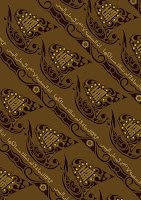Wayang wong also known as Wayang orang (literally human wayang) is a type of Javanese dance theatrical performance with themes taken from episode of Ramayana or Mahabharata.
While wayang gedog usually the theatrical performance that took the themes from the Panji cycles stories from the kingdom of Janggala, in which the players wear masks known as wayang topeng or wayang gedog. The word "gedog" comes from "kedok", which, like "topeng" means "mask". The main theme is the story of Raden Panji and Candra. This is a love story about princess Candra Kirana of Kediri and Raden Panji Asmarabangun, the crown prince of Jenggala. Candra Kirana was the incarnation of Dewi Ratih (goddess of love) and Panji was an incarnation of Kamajaya (god of love). Kirana's story was given the title "Smaradahana" ("The fire of love"). At the end of the complicated story they finally can marry and bring forth a son, named Raja Putra. Panji Asmarabangun ruled Jenggala under the official names "Sri Kameswara", "Prabu Suryowiseso", and "Hino Kertapati". Originally, wayang wong was performed only as an aristocratic entertainment in four palaces of Yogyakarta and Surakarta. In the course of time, it spread to become a popular and folk form as well.
For female performers: Kshatriya noblemen. Costumes and props distinguish kings, kshatriyas, monks, princesses, The movements known as nggruda or ngenceng encot in the classical high style of dance consist of nine basic movements (joged pokok) and twelve other movements (joged gubahan and joged wirogo) and are used in portraying Bedoyo and Srimpi.
Today, the wayang wong, following the Gagrak style of Surakarta, is danced by women. They follow the alus movements associated with a Kshatriya, resembling Arjuna. Following the Gagkra style from Yogyakarta a male dancer uses these same Alus movements to depict princes and generals. There are about 45 distinct character types.
While wayang gedog usually the theatrical performance that took the themes from the Panji cycles stories from the kingdom of Janggala, in which the players wear masks known as wayang topeng or wayang gedog. The word "gedog" comes from "kedok", which, like "topeng" means "mask". The main theme is the story of Raden Panji and Candra. This is a love story about princess Candra Kirana of Kediri and Raden Panji Asmarabangun, the crown prince of Jenggala. Candra Kirana was the incarnation of Dewi Ratih (goddess of love) and Panji was an incarnation of Kamajaya (god of love). Kirana's story was given the title "Smaradahana" ("The fire of love"). At the end of the complicated story they finally can marry and bring forth a son, named Raja Putra. Panji Asmarabangun ruled Jenggala under the official names "Sri Kameswara", "Prabu Suryowiseso", and "Hino Kertapati". Originally, wayang wong was performed only as an aristocratic entertainment in four palaces of Yogyakarta and Surakarta. In the course of time, it spread to become a popular and folk form as well.
For female performers: Kshatriya noblemen. Costumes and props distinguish kings, kshatriyas, monks, princesses, The movements known as nggruda or ngenceng encot in the classical high style of dance consist of nine basic movements (joged pokok) and twelve other movements (joged gubahan and joged wirogo) and are used in portraying Bedoyo and Srimpi.
Today, the wayang wong, following the Gagrak style of Surakarta, is danced by women. They follow the alus movements associated with a Kshatriya, resembling Arjuna. Following the Gagkra style from Yogyakarta a male dancer uses these same Alus movements to depict princes and generals. There are about 45 distinct character types.







 Wayang kulit as seen from the shadow side
Wayang kulit as seen from the shadow side A Dalang performing Wayang Kulit in Java, circa 1890.
A Dalang performing Wayang Kulit in Java, circa 1890. Wayang shadow-puppet (Bali, early 20th century)
Wayang shadow-puppet (Bali, early 20th century) 






























 Batik Buketan Pekalongan shows European flower bouquet
Batik Buketan Pekalongan shows European flower bouquet









